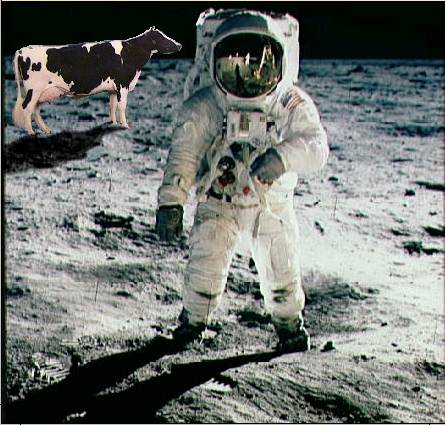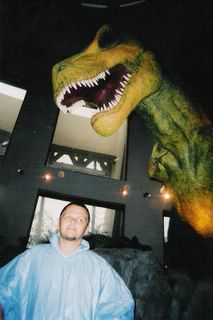What Every Fashionable Astronaut Will Be Wearing...
This Suit Is Made for Walking (on Mars)
from Christian Science Monitor
In 1972, when humans last visited the surface of the moon, the bulky, stiff legs of spacesuits made the "moonwalk" more of a swaying hop. But when explorers get back to the moon, or if they ever get to Mars, these old spacesuits aren't going to cut it, scientists say. Astronauts will need added mobility and dexterity for the next stage of modern experiments, exploration, and construction.
"The current spacesuits, they tend to be gas bags," says Bob Cassanova, director of the NASA Institute for Advanced Concepts (NIAC), which funded the research. "They're gas-pressurized, very bulky, very heavy, very cumbersome."
By combining an old idea with the latest technology, Dr. Dava Newman, a researcher at Massachusetts Institute of Technology, and her team are trying to build a better spacesuit: the BioSuit, a form-fitting "second skin," designed for lunar and Martian living.
BioSuit, a form-fitting "second skin," designed for lunar and Martian living.
The proposed BioSuit will consist of a skintight body suit, a hard torso and backpack for life-support systems and equipment, and a domed helmet. The conceptual images for the project look like science fiction: sleek, color-coded spacemen and spacewomen climbing Martian windmills, whacking red rocks with hammers, and casually shaking hands.
Much of the technology needed to make the BioSuit practical may be decades away - just like a Mars mission - but the idea behind it was dreamed up decades ago. In the late 1960s, Paul Webb, a former Air Force physician, tried to create a spacesuit that used mechanical counterpressure - squeezing - instead of gas pressure.
Dr. Webb made a suit of six layers of elastic that physically pressed the body to mimic Earth's air pressure. The design was lighter and less bulky and provided greater range of motion than a "gas bag." Webb tested the suit and its physiological effects and wrote a report in 1971 that said the idea was viable and safe. But NASA didn't bite.
Thirty years later, Newman, a professor of aeronautics and astronautics, took up the challenge. "I think it was a great idea, just before its time because we didn't have the materials technology," she says.
Newman's team has made several lower-leg prototypes, including one of nylon-spandex, one of elastic wrapped like bandage, and another of pressurized foam painted with layers of urethane.
Ultimately, the BioSuit must maintain fairly constant pressure over the whole body as it moves. With three-dimensional mapping and scanning, Newman's lab studies how skin stretches and joints move.
"I just marvel at it," says Newman. "Every day, I look at the skin and say, 'How could this be designed so fantastically?'"
Making the BioSuit easy to put on is another challenge. It might feel a bit like squeezing into a wetsuit several sizes too small. It took two helpers 20 minutes to tug on the layered elastic suit Webb developed decades ago.
It still is a problem, which is why Newman and other researchers are looking to "smart" materials, metals and polymers that expand, contract, or change their properties in response to heat or electricity.
from Christian Science Monitor
In 1972, when humans last visited the surface of the moon, the bulky, stiff legs of spacesuits made the "moonwalk" more of a swaying hop. But when explorers get back to the moon, or if they ever get to Mars, these old spacesuits aren't going to cut it, scientists say. Astronauts will need added mobility and dexterity for the next stage of modern experiments, exploration, and construction.
"The current spacesuits, they tend to be gas bags," says Bob Cassanova, director of the NASA Institute for Advanced Concepts (NIAC), which funded the research. "They're gas-pressurized, very bulky, very heavy, very cumbersome."
By combining an old idea with the latest technology, Dr. Dava Newman, a researcher at Massachusetts Institute of Technology, and her team are trying to build a better spacesuit: the
 BioSuit, a form-fitting "second skin," designed for lunar and Martian living.
BioSuit, a form-fitting "second skin," designed for lunar and Martian living.The proposed BioSuit will consist of a skintight body suit, a hard torso and backpack for life-support systems and equipment, and a domed helmet. The conceptual images for the project look like science fiction: sleek, color-coded spacemen and spacewomen climbing Martian windmills, whacking red rocks with hammers, and casually shaking hands.
Much of the technology needed to make the BioSuit practical may be decades away - just like a Mars mission - but the idea behind it was dreamed up decades ago. In the late 1960s, Paul Webb, a former Air Force physician, tried to create a spacesuit that used mechanical counterpressure - squeezing - instead of gas pressure.
Dr. Webb made a suit of six layers of elastic that physically pressed the body to mimic Earth's air pressure. The design was lighter and less bulky and provided greater range of motion than a "gas bag." Webb tested the suit and its physiological effects and wrote a report in 1971 that said the idea was viable and safe. But NASA didn't bite.
Thirty years later, Newman, a professor of aeronautics and astronautics, took up the challenge. "I think it was a great idea, just before its time because we didn't have the materials technology," she says.
Newman's team has made several lower-leg prototypes, including one of nylon-spandex, one of elastic wrapped like bandage, and another of pressurized foam painted with layers of urethane.
Ultimately, the BioSuit must maintain fairly constant pressure over the whole body as it moves. With three-dimensional mapping and scanning, Newman's lab studies how skin stretches and joints move.
"I just marvel at it," says Newman. "Every day, I look at the skin and say, 'How could this be designed so fantastically?'"
Making the BioSuit easy to put on is another challenge. It might feel a bit like squeezing into a wetsuit several sizes too small. It took two helpers 20 minutes to tug on the layered elastic suit Webb developed decades ago.
It still is a problem, which is why Newman and other researchers are looking to "smart" materials, metals and polymers that expand, contract, or change their properties in response to heat or electricity.







 what the Great Conjunction is. 'What's the Great Conjunction?'
what the Great Conjunction is. 'What's the Great Conjunction?' 




 A Is for Androids
A Is for Androids B Is for Boba
B Is for Boba C Is for Calvin
C Is for Calvin D Is for Dragons
D Is for Dragons E Is for Elric
E Is for Elric F Is for Futures
F Is for Futures G Is for Genie
G Is for Genie H Is for Hobbits
H Is for Hobbits I Is for Iceman
I Is for Iceman J Is for Jedi
J Is for Jedi K Is for Kraken
K Is for Kraken





































































2 Comments:
...which is to say, the spacesuit of the future will be a full-body girdle.
KINKY...! This could be fun. Imagine being fondled and groped in such a spacesuit.
Might be all that's needed to get more people interested in space travel.
I wouldn't mind if some astronaut chick groped my crotch while I was wearing a suit like that.
Post a Comment
<< Home